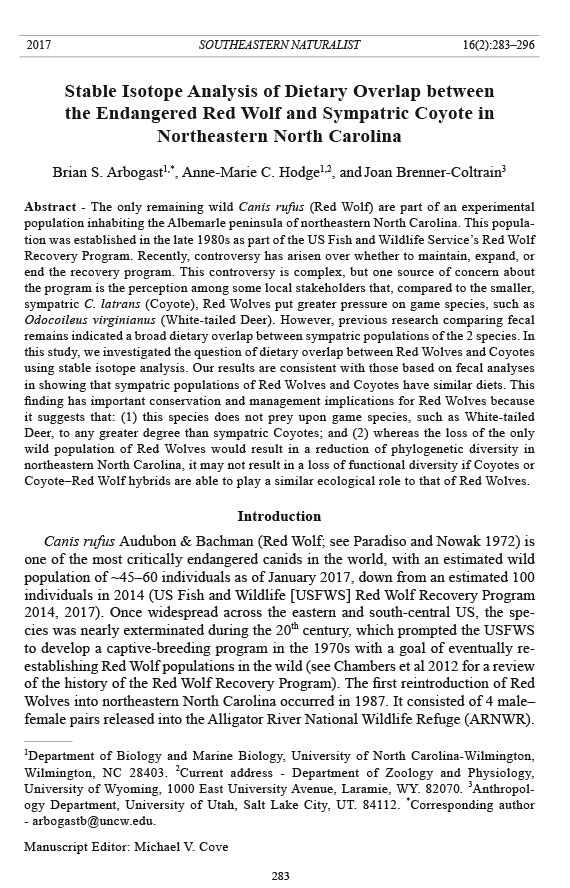
RED WOLF WITH PUP AND IN THE FIELD
Diets of sympatric red wolves and coyotes in northeastern North Carolina
J Mammal (2013) 94 (5): 1141-1148.
15 October 2013
taxa deposited each scat and multinomial modeling designed for mark–recapture data to investigate diets of sympatric red wolves and coyotes. Diets of red wolves and coyotes did not differ, but the proportion of small rodents in the composite scats of both canids was greater in the spring than in the summer. White-tailed deer (Odocoileus virginianus), rabbits (Sylvilagus spp.), and small rodents were the most common diet items in canid scats. The similarity of diet between red wolves and coyotes suggests that these 2 species may be affecting prey populations similarly.
Coyotes in North Carolina can be Eastern Coyotes(mixed with Red/Eastern Wolf lineage)
Before European settlement, the ranges of the coyote (Canis latrans) and red wolf (Canis rufus) were largely allopatric; coyotes were limited primarily to the prairie regions of North America (Bekoff 1977), whereas red wolves occurred exclusively in eastern North America (Nowak 2002). The reintroduction and sustained management of red wolves in northeastern North Carolina following the recent expansion of coyotes into the eastern United States has created the unique circumstance of sympatric red wolf and coyote populations on the Albemarle Peninsula. Because the 2 species historically had mostly nonoverlapping ranges, little is known about their interspecific interactions or their combined effects on ecological communities.
In particular, the effects of predation on prey species by sympatric red wolves and coyotes are unknown. Clearly, in some situations canids have the ability to reduce prey populations (Seip 1995). A population of black-tailed deer (Odocoileus hemionus) in Alaska was brought to near extinction by gray wolf (Canis lupus) predation (Klein 1995), and reintroduced gray wolves reduced ungulate abundance in Yellowstone National Park (Barber-Meyer et al. 2008). Canids also can have indirect effects on prey populations. For example,Crooks and Soulé (1999) suggested that the disappearance of coyotes in California resulted in increased numbers of mesopredators and a subsequent increase in predation upon native prey species by mesopredators
Coyotes in North Carolina can also be Western Coyotes,
not mixed with Red/Eastern Wolf lineage
not mixed with Red/Eastern Wolf lineage
.Red wolves and coyotes are considered opportunistic carnivores, even though red wolf diets are relatively undocumented in the wild. In their historic range throughout the southeastern United States, the last remaining red wolves preyed upon raccoons (Procyon lotor), rabbits (Sylvilagus spp.), and hispid cotton rats (Sigmodon hispidus—Riley and McBride 1972; Shaw 1975; Weller 1996) in coastal habitats of Texas and Louisiana. In the few diet studies of red wolves reintroduced to North Carolina, white-tailed deer (Odocoileus virginianus) also contributed significantly to the diet (Dellinger et al. 2011a;Kelly 1994).
Following extirpation of wolves in the eastern United States, coyotes expanded their range eastward (Hill et al. 1987; Gompper 2002; Laliberte and Ripple 2004). Coyotes are smaller and are thought to eat fewer large prey items (e.g., white-tailed deer and raccoons) than red wolves. Coyotes have a diverse diet that includes small and medium-sized mammals, vegetation, dump refuse, white-tailed deer, and domestic livestock (Hilton 1978;Gompper 2002; Schrecengost et al. 2008). Except in Florida and South Carolina, where vegetation was most abundant in scats, mammalian prey (e.g., rabbits and small rodents) have occurred most frequently in analyses of coyote diets in the southeastern United States (Gipson 1974; Hall 1979;Wooding 1984; Lee 1986; Blanton and Hill 1989; Schrecengost et al. 2008). In addition, Schrecengost et al. (2008) reported white-tailed deer fawns to be the most common component of coyote diets during the period of deer parturition and fawn rearing in South Carolina, and coyotes have apparently replaced gray wolves as an important predator of white-tailed deer in the northeastern United States (Gompper 2002; Kays et al. 2010). Thus, empirical evidence suggests that the diets of coyotes and red wolves may overlap and that coyotes may have filled a niche similar to that historically occupied by red wolves across the eastern and southern United States.
The sympatry of red wolves and coyotes in eastern North Carolina provides a unique opportunity to compare food habits of these 2 canids directly. In allopatry, diet studies do not include the potential influence of interspecific competition and can be confounded by seasonal or habitat differences in prey availability (Andelt et al. 1987). Conversely, analysis of the diets of sympatric red wolves and coyotes within the same time frame and across the same landscapes reduces spatial and temporal variability and provides initial data on the potential combined effects of these predators on prey populations. We compared food habits of red wolves and coyotes using 2 recently developed methods: fecal DNA identification of canid taxa and multinomial analysis of food habits. We used a capture–mark–recapture model to test our hypothesis that diet would differ between red wolves and coyotes and diet, in general, would differ by biological seasons and calendar periods.













No comments:
Post a Comment